Unit2Language.it的用法(知识梳理)
第05讲Unit2(知识全梳理考点精准练)-暑假学案新七年级英语暑假提升精品
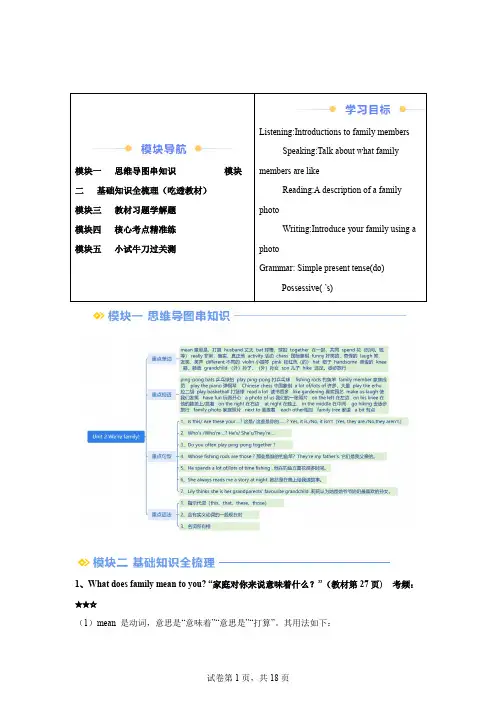
模块一思维导图串知识模块二基础知识全梳理(吃透教材)模块三教材习题学解题模块四核心考点精准练模块五小试牛刀过关测Listening:Introductions to family membersSpeaking:Talk about what familymembers are likeReading:A description of a familyphotoWriting:Introduce your family using aphotoGrammar: Simple present tense(do)Possessive( ’s)1、What does family mean to you? “家庭对你来说意味着什么?”(教材第27页)考频:★★☆(1)mean 是动词,意思是“意味着”“意思是”“打算”。
其用法如下:①mean sth.意味着…Success means a lot to him. 成功对他意味着很多。
①mean doing sth.意味着做某事Giving up smoking means taking good care of your health. 戒烟意味着好好照顾你的健康。
①mean to do sth. 打算做某事I mean to go to the park this weekend. 我打算这个周末去公园。
(2)family名词,此处意为“家;家庭”,还可指“家庭成员”,其具体用法如下:①家;家庭,谓语动词用单数①家庭成员谓语动词用复数Her family is big.她的家庭很大。
Her family are all tall.她的家人个子都很高。
2、一Are these your ...?这些是你的父母吗?一Yes,they are.是的,他们是。
(教材第28页1d)考频:★★★(1)“Are these?”意为“这(些)是……吗?”,是“These are…”的一般疑问句形式;“Are those…?”意为“那(些)是……吗?”,是“Those are…”的一般疑问句形式。
Unit2Theuniversallanguage省略句(知识梳理)
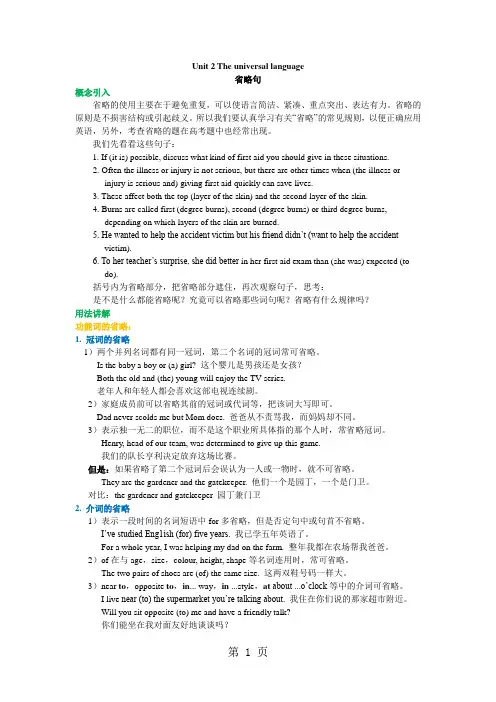
Unit 2 The universal language省略句概念引入省略的使用主要在于避免重复,可以使语言简洁、紧凑、重点突出、表达有力。
省略的原则是不损害结构或引起歧义。
所以我们要认真学习有关“省略”的常见规则,以便正确应用英语,另外,考查省略的题在高考题中也经常出现。
我们先看看这些句子:1. If (it is) possible, discuss what kind of first aid you should give in these situations.2. Often the illness or injury is not serious, but there are other times when (the illness orinjury is serious and) giving first aid quickly can save lives.3. These affect both the top (layer of the skin) and the second layer of the skin.4. Burns are called first (degree burns), second (degree burns) or third degree burns,depending on which layers of the skin are burned.5. He wanted to help the accident victim but his friend didn’t (want to help the accidentvictim).6. To her teacher’s surprise, she did better in her first aid exam than (she was) expected (todo).括号内为省略部分,把省略部分遮住,再次观察句子,思考:是不是什么都能省略呢?究竟可以省略那些词句呢?省略有什么规律吗?用法讲解功能词的省略:1. 冠词的省略1)两个并列名词都有同一冠词,第二个名词的冠词常可省略。
人教版(2019)选择性必修第三册Unit2-Unit5 重点词块知识清单素材
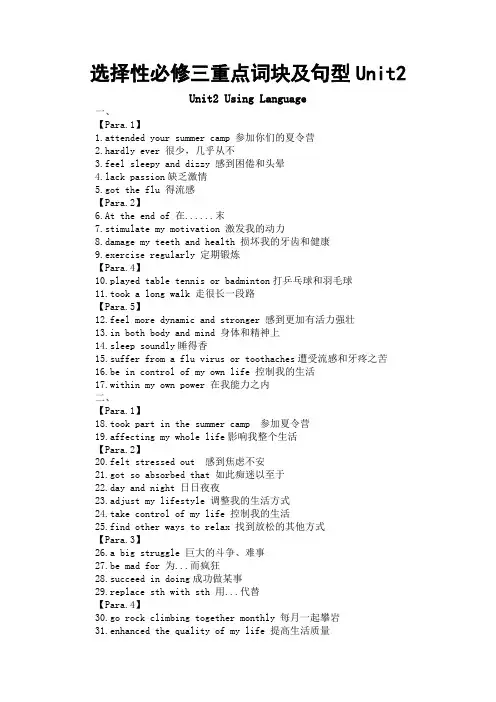
选择性必修三重点词块及句型Unit2Unit2 Using Language一、【Para.1】1.attended your summer camp 参加你们的夏令营2.hardly ever 很少,几乎从不3.feel sleepy and dizzy 感到困倦和头晕ck passion缺乏激情5.got the flu 得流感【Para.2】6.At the end of 在......末7.stimulate my motivation 激发我的动力8.damage my teeth and health 损坏我的牙齿和健康9.exercise regularly 定期锻炼【Para.4】10.played table tennis or badminton打乒乓球和羽毛球11.took a long walk 走很长一段路【Para.5】12.feel more dynamic and stronger 感到更加有活力强壮13.in both body and mind 身体和精神上14.sleep soundly睡得香15.suffer from a flu virus or toothaches遭受流感和牙疼之苦16.be in control of my own life 控制我的生活17.within my own power 在我能力之内二、【Para.1】18.took part in the summer camp 参加夏令营19.affecting my whole life影响我整个生活【Para.2】20.felt stressed out 感到焦虑不安21.got so absorbed that 如此痴迷以至于22.day and night 日日夜夜23.adjust my lifestyle 调整我的生活方式24.take control of my life 控制我的生活25.find other ways to relax 找到放松的其他方式【Para.3】26.a big struggle 巨大的斗争、难事27.be mad for 为...而疯狂28.succeed in doing成功做某事29.replace sth with sth 用...代替【Para.4】30.go rock climbing together monthly 每月一起攀岩31.enhanced the quality of my life 提高生活质量32.get refreshed through climbing 通过攀岩变得神清气爽【Para.5】33.trying out new ways of relaxing 尝试放松的新方法34.feel much more energetic 感到更加有活力35.change myself for the better 让自己变得更好36.be true for sb.对....来说是真的37.it might truly be possible to 有可能做某事38.Be the change you want to see in the world 欲变世界,先变其身【重点句子】1.Whenever I went out with friends.I brought snacks from home, things that didn't have any added sugar: fruit, nuts, dried meat, etc.每当我和朋友出去的时候,我都会从家里带一些零食,一些没有添加任何糖分的东西:水果、坚果、肉干等等。
英语1(基础模块)第2版--unit-2-知识点及练习
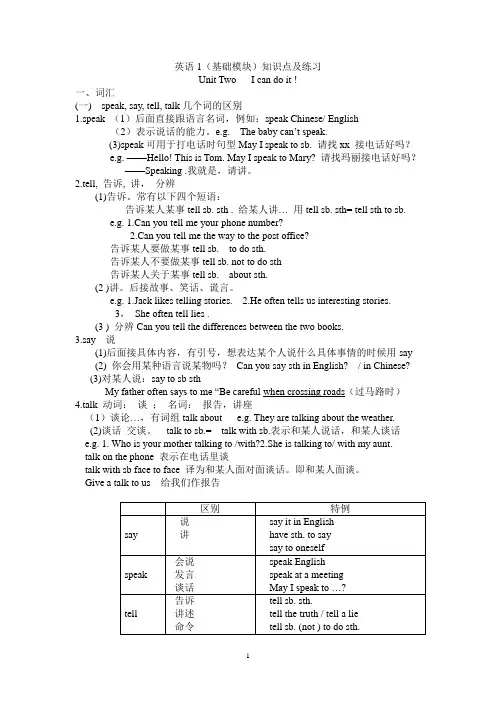
英语1(基础模块)知识点及练习Unit Two I can do it !一、词汇(一) speak, say, tell, talk几个词的区别1.speak (1)后面直接跟语言名词,例如:speak Chinese/ English(2)表示说话的能力。
e.g. The baby can’t speak.(3)speak可用于打电话时句型May I speak to sb. 请找xx 接电话好吗?e.g. ——Hello! This is Tom. May I speak to Mary? 请找玛丽接电话好吗?——Speaking .我就是,请讲。
2.tell, 告诉, 讲,分辨(1)告诉。
常有以下四个短语:告诉某人某事tell sb. sth . 给某人讲… 用tell sb. sth= tell sth to sb.e.g. 1.Can you tell me your phone number?2.Can you tell me the way to the post office?告诉某人要做某事tell sb. to do sth.告诉某人不要做某事tell sb. not to do sth告诉某人关于某事tell sb. about sth.(2 )讲。
后接故事、笑话、谎言。
e.g. 1.Jack likes telling stories. 2.He often tells us interesting stories.3,She often tell lies .(3 ) 分辨Can you tell the differences between the two books.3.say 说(1)后面接具体内容,有引号,想表达某个人说什么具体事情的时候用say(2) 你会用某种语言说某物吗?Can you say sth in English? / in Chinese?(3)对某人说:say to sb sthMy father often says to me “Be careful when crossing roads(过马路时)4.talk 动词:谈;名词:报告,讲座(1)谈论…,有词组talk about e.g. They are talking about the weather.(2)谈话交谈。
9下 Unit 1【刷语法】it的用法(重点语法提升练)
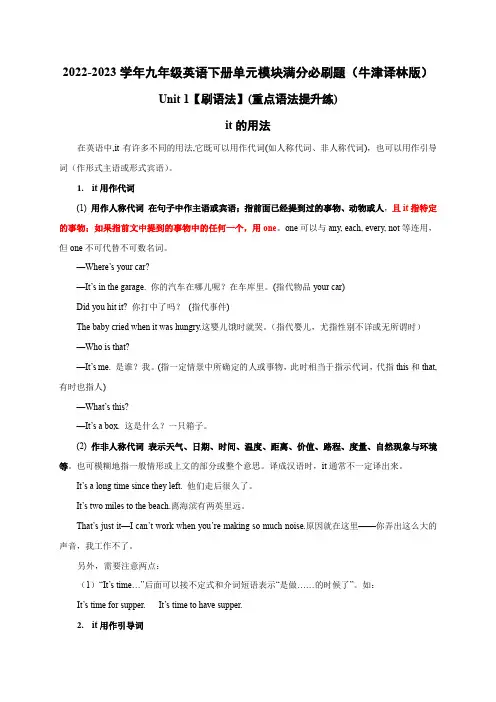
2022-2023学年九年级英语下册单元模块满分必刷题(牛津译林版)Unit 1【刷语法】(重点语法提升练)it的用法在英语中,it有许多不同的用法,它既可以用作代词(如人称代词、非人称代词),也可以用作引导词(作形式主语或形式宾语)。
1.it用作代词(1) 用作人称代词在句子中作主语或宾语;指前面已经提到过的事物、动物或人,且it指特定的事物;如果指前文中提到的事物中的任何一个,用one。
one可以与any, each, every, not等连用,但one不可代替不可数名词。
—Where’s your car?—It’s in the garage. 你的汽车在哪儿呢?在车库里。
(指代物品your car)Did you hit it? 你打中了吗?(指代事件)The baby cried when it was hungry.这婴儿饿时就哭。
(指代婴儿,尤指性别不详或无所谓时)—Who is that?—It’s me. 是谁?我。
(指一定情景中所确定的人或事物,此时相当于指示代词,代指this和that,有时也指人)—What’s this?—It’s a box. 这是什么?一只箱子。
(2) 作非人称代词表示天气、日期、时间、温度、距离、价值、路程、度量、自然现象与环境等。
也可模糊地指一般情形或上文的部分或整个意思。
译成汉语时,it通常不一定译出来。
It’s a long time since they left. 他们走后很久了。
It’s two miles to the beach.离海滨有两英里远。
That’s just it—I can’t work when you’re making so much noise.原因就在这里——你弄出这么大的声音,我工作不了。
另外,需要注意两点:(1)“It’s time…”后面可以接不定式和介词短语表示“是做……的时候了”。
如:It’s time for supper. It’s time to have supper.2.it用作引导词(1) 作形式主语由动词不定式、动词-ing短语或名词性从句担任主语的句子,常用it来作形式主语,而把真正的主语放在句子的后面。
【高中英语教材知识梳理】必修一 Unit 2
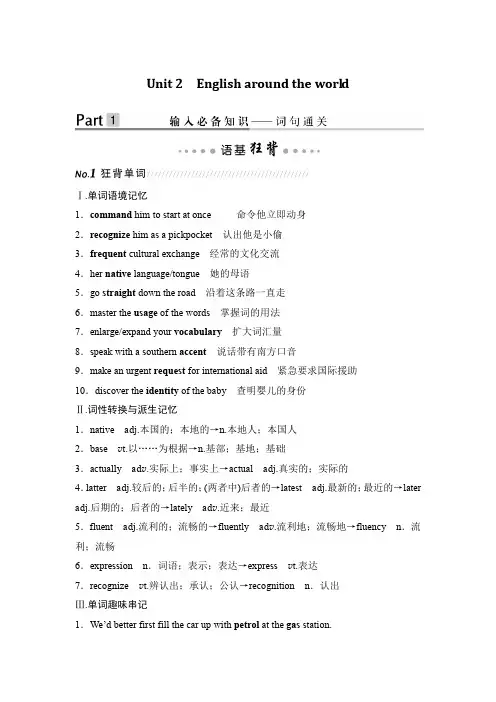
Unit 2English around the worldⅠ.单词语境记忆1.command him to start at once 命令他立即动身2.recognize him as a pickpocket 认出他是小偷3.frequent cultural exchange 经常的文化交流4.her native language/tongue 她的母语5.go straight down the road 沿着这条路一直走6.master the usage of the words 掌握词的用法7.enlarge/expand your vocabulary扩大词汇量8.speak with a southern accent说话带有南方口音9.make an urgent request for international aid 紧急要求国际援助10.discover the identity of the baby 查明婴儿的身份Ⅱ.词性转换与派生记忆1.native adj.本国的;本地的→n.本地人;本国人2.base v t.以……为根据→n.基部;基地;基础3.actually ad v.实际上;事实上→actual adj.真实的;实际的4.latter adj.较后的;后半的;(两者中)后者的→latest adj.最新的;最近的→later adj.后期的;后者的→lately ad v.近来;最近5.fluent adj.流利的;流畅的→fluently ad v.流利地;流畅地→fluency n.流利;流畅6.expression n.词语;表示;表达→express v t.表达7.recognize v t.辨认出;承认;公认→recognition n.认出Ⅲ.单词趣味串记1.We’d better first fill the car up with petrol at the gas station.我们最好先到加油站去给汽车加满汽油。
鲁教版(五四制)六年级英语上册Unit2重难点知识点归纳
Unit2重难点知识点归纳一、重点词汇1. what2. is3. this4. in5. English6. map7.cup8. ruler9. pen 10. orange 11. jacket 12. key13. that 14. spell 15. please二、重点短语1. in English 用英语2. an orange 一个橙子3. a jacket 一件夹克衫4. a map 一张地图5. spell it 拼写它6.a ruler 一把尺子7. a key 一把钥匙8. a pen 一支钢笔9. a cup 一个杯子三、重点句型1.—What’s this in English?—It’s a key.【用法】“in +某种语言”表示“用某种语言”a+以辅音音素开头的单数可数名词2.—What’s that in English?—It’s an orange.【用法】an+以元音音素开头的单数可数名词3. —Spell it, please!—K-E-Y.【用法】Spell…,please. 请拼写……四、语法1. 人称代词it的用法人称代词it在句子中作主语或宾语,意为“它”,常用来代替上文出现的物品,也可代替指示代词this/that,常和be动词is连用,可缩写为it’s。
2. 指示代词this/that的用法指示代词this常用来指近处的单个物品;指示代词that常用来指远处的单个物品。
3. 不定冠词a/an的用法冠词是置于名词之前,说明名词所表示的人或事物的一种虚词。
不定冠词常表示“一”的概念,有两种形式:a和an。
a用在以辅音音素开头的名词前,an用在以元音音素开头的名词前。
特殊情况:(1)元音字母u的读音以辅音音素开头,因此“一个u”应表达为“a u”。
(2)以元音字母开头的词以辅音音素开头,其前面用a。
如:a useful book 一本有用的书a uniform 一套制服a European country 一个欧洲国家(3)以辅音字母开头的词,辅音字母不发音,而以元音音素开头,其前面用an。
沪教版初中英语八年级下册Unit 2知识点梳理
沪教版初中英语八年级下册Unit 2知识点梳理Unit 2 Body language【词汇精讲】1. acceptaccept是动词,意为“接受,收受”。
例如:She accepted his flowers happily. 她高兴地接受了他的花。
【拓展】receive和accept的辨析:(1)receive和accept都有“接收”的意思。
receive表示客观上收到,而accept表示主观上接受。
I received his invitation but did not accept it. 我收到了他的请帖,但并没有接受他的邀请。
(2)receive通常指被动地“收到”或“接到”,而accept则指主动地“接受”。
We haven't received his letter for a long time. 我们很久没有收到他的来信了。
She offered him a lift and he accepted (it). 她请他坐她的车,他接受了。
(3)表示“接见、接待”时,要用receive而不用accept。
She was warmly received.她受到热情接待。
2. messagemessage 意为“消息,信息”。
take a message 意为“捎个口信”;leave a message 意为“留个口信”;send a message 意为“发送信息”。
例如:Can I take a message for him? 我能给他捎个口信吗?He sent a message to me yesterday. 他昨天给我发了一条信息。
【拓展】辨析information, news与messageinformation 表示通过打听、观察及学习获得的资料。
news是不可数名词,意为“消息,新闻”,指通过广播、电视及报纸报道的事。
message是可数名词,意为“口信,消息”,指通过口头或笔头传递给他人的消息。
沪教牛津版初中英语九年级下册Unit 2知识点梳理
沪教牛津版初中英语九年级下册Unit 2知识点梳理Unit2单词culture shock ['kʌltʃə] [ʃɒk] 文化冲击;文化休克camp [kæmp] 度假营*firework ['faɪəwɜːk] 烟火;烟花*turkey ['tɜːkɪ] 火鸡international [ɪntə'næʃ(ə)n(ə)l] 国际的admit [əd'mɪt] (常指勉强)承认spare [speə] 空闲的;空余的degree [dɪ'griː] 程度fail [feɪl] 失败;未能(做到)manage ['mænɪdʒ] 完成(困难的事);勉力完成人生在勤,不索何获idiom ['ɪdɪəm] 习语;惯用语everyday ['evrɪdeɪ; -'deɪ] 每天的;日常的uniform ['juːnɪfɔːm] 校服whatever [wɒt'evə] 任何事物;一切事物pink [pɪŋk] 粉红色的purple ['pɜːp(ə)l] 紫色的anyway ['enɪweɪ] 无论如何;反正especially [ɪ'speʃ(ə)lɪ; e-] 尤其;特别baseball ['beɪsbɔːl] 棒球运动education [edjʊ'keɪʃ(ə)n] 有教益的经历state [steɪt] 州,国家national ['næʃ(ə)n(ə)l] 国家的;民族的;全国的president ['prezɪd(ə)nt] 总统vacation [vəˈkeɪʃn; veɪ-] 假期schedule [ˈʃɛdjuːl] 日程安排set off 使(炸弹等)爆炸take off 脱下in one's spare time 在某人的空闲时间里to a certain degree 在某种程度上get used to 习惯于;适应under the weather 略有不适;不得劲Unit2课文Culture shock文化冲击Brad Li is a junior high school student in China. He visited the US on an international exchange last year, and now he is giving a speech about his experience.布兰德·李是中国一所初中的学生。
[精]人教版八年级英语上册Unit2单词、知识梳理、词汇句式精讲
人教版八年级英语上册Unit2单词、知识梳理、词汇句式精讲一、单词housework ['haʊswɜːk] n.家务劳动hardly ['hɑːdli] adv.几乎不;简直不;刚刚ever ['evə(r)] adv.曾经;在任何时候once [wʌns] adv.一次;曾经twice [twaɪs] adv.两倍;两次Internet ['ɪntənet] n.因特网program ['prəʊɡræm] n.节目;程序;课程;节目单full [fʊl] adj.满的;充满的;完全的swing [swɪŋ] n.摇摆;秋千v.摇摆;旋转maybe ['meɪbi] adv.或许;也许;可能swing dance摇摆舞least [liːst] adj.最小的;最少的at least至少hardly ever很少;几乎从不;难得junk n.垃圾;废旧杂物coffee ['kɒfi] n.咖啡;咖啡色health [helθ] n.健康;人的身体或精神状态result [rɪ'zʌlt] .结果;后果percent [pə'sent] adj.百分之...的online [ˌɒn'laɪn] adj.在线的adv.在线的television ['telɪvɪʒn] n.电视机;电视节目although [ɔːl'ðəʊ] conj.虽然;尽管;然而;可是through [θruː] prep.穿过;凭借;一直到body ['bɒdi] n.身体mind [maɪnd] .头脑;想法;意见;心思such [sʌtʃ] adj.这样的;如此的together [tə'ɡeðə(r)] adv.共同;一起die [daɪ] v.死;枯竭;消失writer ['raɪtə(r)] n.作者;作家dentist ['dentɪst] n.牙科医生magazine ['mæɡəziːn] n.杂志however [haʊ'evə(r)] adv.然而;无论如何;不管多么than [ðən] conj.比almost ['ɔːlməʊst] adv.几乎;差不多none [nʌn] pron.没有人;没有任何东西,毫无less [les] adj.更少的;较少的point [pɔɪnt] n.看法;要点;重点;小数点;目标;分数such as例如;诸如junk food n.垃圾食品;无营养食品more than超过;多于;不仅仅;非常less than不到;少于Claire 克莱尔Sue 苏American Teenager 《美国青少年》Unit2 知识梳理【重点短语】1.Clean-Up Day 清洁日2. an old people’s home 养老院3. help out with sth. 帮助解决困难4. used to 过去常常......5. care for 关心;照顾6. the look of joy 快乐的表情7. at the age of 在......岁时8.clean up 打扫(或清除)干净9. cheer up (使)变得更高兴;振奋10. give out 分发;散发11. come up with 想出;提出12. make a plan 制订计划13. make some notices 做些公告牌14. try out 试用;试行15. work for 为…工作;为…. 效力16. put up 建造;举起;张贴17. hand out 分发;散发;发给18. call up 打电话;召集19. put off 推迟;延迟20. for example 比如;例如21. raise money 筹钱;募捐22. take after 与......相像;像23. give away 赠送;捐赠24. fix up 修理;修补;解决25. be similar to 与……相似26. set up 建立;设立27. disabled people 残疾人28. make a difference 影响;有作用29. be able to 能够30. after-school reading program 课外阅读项目【重点句型】1. The boy could give out food at the food bank.这个男孩可以在食品救济站分发食物。
- 1、下载文档前请自行甄别文档内容的完整性,平台不提供额外的编辑、内容补充、找答案等附加服务。
- 2、"仅部分预览"的文档,不可在线预览部分如存在完整性等问题,可反馈申请退款(可完整预览的文档不适用该条件!)。
- 3、如文档侵犯您的权益,请联系客服反馈,我们会尽快为您处理(人工客服工作时间:9:00-18:30)。
Unit 2 Languageit的用法概念引入小词it是我们学英语之初就学会的,是不是感觉它似乎有点无所不能,经常出现呀?那么我们是不是已经了解了it的用法了呢?本单元和下单元我们就把it的用法做一小结。
先看这些句子,想想it的用法是什么?1. It is a beautiful day here and I am sitting under the big tree at the end of the garden.(表天气)2. It seems amazing that at my age I am still fit enough to cycle 20 kilometres in anafternoon.(代替that从句作主语)3. It’s my birthday in two weeks’ time and I’ll be 82 years old!(表时间)4. Your mother tells me that you started smoking some time ago and now you are finding itdifficult to give it up.(第一个it代替to give it up作宾语;第二个it代替上文中“吸烟”的事) 下面我们就先学习it作为代词和形式主语、形式宾语的用法。
用法讲解代词it1. 作人称代词人称代词it是有实义的,是单数第三人称代词。
主格与宾格相同。
1)指代人以外的一切生物或事物,如前文提到的事物或未指明但谈话双方都知道的那件事;宁波是座美丽的城市,是不是?Ningbo is a beautiful city, isn’t it?It doesn’t matter. 没关系。
2)替代前文中的this, that;This is your plan? Will you hand it in? 这是你的计划?你要交上去吗?3)指代婴儿、小孩或性别不明的人。
The baby is crying. It might be hungry. 婴儿在哭,或许饿了。
—Someone is ringing. Who might it be? 有人按门铃,可能是谁呢?—It must be my friend Tom.He (不可用It) wants to see you.一定是我的朋友汤姆,他想要见你。
2. 作非人称代词it用作无人称的主语,不指物,而表示时间、天气、气候、季节、距离等自然现象,或指事物的状态。
What a long way it is from Beijing to London! (it 指距离)从北京到伦敦是多么长的一段距离啊!It was nearly midnight when she came back. (it指时间)她回来时快半夜了。
. (it指环境)It was very quiet in the café咖啡馆里静悄悄的。
(前面的it指季节,后面的it指气温)It’s early spring, but it’s already very hot.刚是初春,但是已经很热了。
(it指情况)If it hadn’t been for the snow, we could have climbed over the mountain.要不是因为下雪,我们可能已经翻越了那座山。
易误辨析区别it,one,it,that和which1. it指上文出现过的同一事物,而one则泛指与前面事物同属一类中的一个。
This was the last dictionary in that bookstore. So I took it.(it特指前面提到的那本词典)这是那家书店最后一本词典,所以我买下了它。
There are many dictionaries in that bookstore. So I bought one. (one泛指其中之一)那家书店有许多词典,所以我买了一本。
2. that做代词替代前面提到的事物, 可数名词、不可数名词皆可。
代替可数名词可以用the one替换。
that的复数形式为those,只可替代可数名词复数,在句中相当于the ones。
The head teacher in your class is younger and more active than that in theirs.你们班的班主任比他们班的班主任年轻而且更活跃。
The students who do best in the exam are not always those with the best brains.考试考得最好的学生并不总是那些最聪明的学生。
3. that在并列分句中,可以替代前面某一个名词或整个句子内容,可用it替换.She heard a terrible noise, and that brought her heart into her mouth.她听见一个可怕的声音,让她的心跳到了嗓子眼。
4. it和which都可以用来指某一件事,关键要看中间是否有并列连词,如果有就用it,反之用which。
The Smiths bought a new house, but it will need a lot of work before they can move in.史密斯家买了一座新房子,但是搬进去之前还需要大量的工作。
(it 指代前面提到的那所房子,此句的关键词是but,连接两个分句,it是分句的主语)The Smiths bought a new house, which will need a lot of work before they can move in.(因为没有连词,不能用it;which代表先行词house在定语从句中作主语。
)He was badly ill, and it made his mother worried. 他病了,那使他母亲很担心。
(it指代“他病了”这件事,注意and。
)He was badly ill, which made his mother worried.(which代表前面整个主句,在定语从句中作主语)it作形式主语it作形式主语和形式宾语时,一般称为引导词,引出特定的句型。
it作形式主语,代替由不定式,动名词或从句表示的真正主语。
不定式、动名词或从句都可以作主语,如:To say is one thing, and to do is another. (不定式作主语)说是一回事,做是另一回事。
Seeing is believing. 眼见为实。
(动名词作主语)That he is a hero is true. (从句作主语)当主语过长时,就会有不平衡感,为了句子的平衡、美观,我们引入了引导词的概念。
1) 代替由不定式表示的真正主语句型:It is + adj. / n. +for/of sb. to do sth.It is impolite to talk loudly in public places. 在公共场合大声说话是不礼貌的。
)(it代替不定式“to talk loudly in public places”为什么形容词后有时用for,有时用of呢?仔细观察这两个句型:It is important (necessary, possible, impossible, easy, hard, difficult…) for sb. to do sth.It is nice (cruel, kind, rude, wise, stupid, c lever, foolish, polite…) of sb. to do sth.我们可以得出这样的结论:当形容词只是修饰这件事时,用for sb.,我们可以称为“单层修饰”;如果形容词看上去是修饰人的,而且事情做出来也肯定是这样的,即形容词既修饰人,也修饰物时,用of。
例如:我们学英语很重要。
It’s important for us to learn English.important是修饰“我们”,还是修饰“学英语”这件事呢?修饰“学英语”这件事,所以用for。
再如:你帮助我真好。
It’s very kind of you to help me.第一,“你”是好的;第二“帮助我”这件事也是好的,所以双重修饰就用of。
2)可代替动名词表示的真正主语。
It’s no use crying over spilt milk. 覆水难收。
It’s no good taking in much fat and sugar. 吸收过多的脂肪和糖没有好处。
It’s no fun watching the same movie for a second time. 同一部电影再看一遍没有意思。
这里crying...等动名词短语是真正的主语,it代替它们作形式主语。
这些句型与前面的句型类似,那么什么时候要加-ing形式呢?我们只需记住,动名词的这种句型是比较少的,记住一些固定用法即可,如在高考中经常出现的It’s no use/ no good/ no fun doing sth. 做某事没有用/没有好处/没有意思。
3)代替主语从句我没有早一点这么想真是遗憾。
It’s a pity that I didn’t think of it earlier.It is a well-known fact that smoking can cause cancer.吸烟会引起癌症是尽人皆知的事实。
it代替that引导的主语从句作形式主语。
注意:选it还是as:It is well known to all that the earth is round. 众所周知,地球是圆的。
这个句子中it代替that引导的从句作形式主语,经常会与下面这个定语从句的句型混淆:_______ is well known to all, the earth is round.这个句子中,第一个典型特征是逗号,第二是逗号后没有that,也就没有形式主语了。
,在定语从句中作主语。
空白处应该填As。
As代替后面的句子“the earth is round”这两种形式要清晰地记住。
4)注意以下固定句型:It seems (ed) / appears (ed) that ... 似乎......It (so) happened that ... 碰巧.....It turns (ed) out that... 结果是It occurred to sb. that ... 某人突然想起......It is said / reported / believed / hoped / well known / suggested ... that...据说/据报道/大家都相信/人人都希望/大家都知道/有人建议......例如:It so happened that the tickets were sold out. 碰巧票都卖光了。
